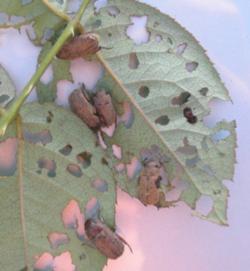Insect hot topics: Chinese Rose Beetle
by James Bethke
This column focuses on insects that pose a threat to the ornamental plant production industry and have good potential for invasion and establishment in California.
As some of you are probably aware, the California Department of Food and Agriculture has been fighting a persistent infestation of the Japanese beetle in small residential areas near Sacramento. I have written about the threat that the Japanese beetle poses to California landscape and agriculture in a previous issue of “Insect Hot Topics;”(UCNFA News, Spring 2014, Volume 18. issue 1). Recently, inspectors intercepted a package of purple sweet potatoes from Hawaii and found a very similar beetle, the Chinese rose beetle (Adoretus sinicus Burmeister), which is an economically important pest in Southeast Asia, China and many Pacific islands including Hawaii (McQuate and Jameson 2011). It is thought to originate from Japan and Taiwan. The Chinese rose beetle is noteworthy and everyone should be on the lookout for this pest.
The Japanese beetle is a very serious landscape pest and anyone who has lived back east is very familiar with the damage and nuisance the Japanese beetle presents. The Chinese rose beetle is equally as polyphagous and could be a threat to landscapes, ornamental production and agriculture in California. Like other chafers, adults are generalist foliage feeders and can feed on over 500 plant species (Hession et al. 1994). According to McQuate and Jameson (2011 and references therein), host plants include broccoli, cabbage, cacao, Chinese broccoli and cabbage, chiso, corn, cotton, cucumber, eggplant, ginger, grape, green beans, jack fruit, okra, peanuts, Oriental persimmon, raspberry, roses, salak palm, soybean, star fruit, strawberry, sweet potato, taro and tea.
The adult Chinese rose beetle is reddish brown and about ½ inch long (fig. 1). Adults come out at dusk and feed for a couple of hours before retreating to the duff at the base of nearby plants. The Chinese rose beetle causes very characteristic feeding damage, producing paired holes in leaves and often leaving a narrow strip of leaf intact in the middle. The characteristic interveinal feeding is caused by the beetle's unusual mouthparts. When feeding on a leaf surface, the beetle uses only one side of its mouth at a time. Dr. Arnold Hara from the University of Hawaii says that leaves can look like lace or like they have been peppered with buckshot, and there may be nothing left but the veins (fig. 1).

Like other scarab beetle grubs found in California and elsewhere, grubs are c-shaped and live in rich soil, leaf litter, decaying vegetation, or compost, where they feed on dead plant tissues. They are not known to be live root feeders causing root damage.
Like other invasives, control options are far and few between. There are no current biological control options, and pesticide control options are limited, especially considering the wide range of crops that can be attacked. General broad-spectrum products such as organophosphates and carbamates and are considered suppressive. Additionally, tests of synthetic lures developed for Japanese beetles and other scarab beetles failed to demonstrate attractiveness for Chinese rose beetles, which poses a challenge to trapping and detection.
Pesticides, kairomones (plant-based attractants) and pheromones (sex and aggregation) are critical for managing existing pest populations as well as for countering new invasions that are likely to occur, largely due to the movement of agricultural goods. Hopefully, research will identify good management options in the future.
References
Crop Knowledge Master. 1991. Adoretus sinicus (Burmeister). http://www.extento.hawaii.edu/kbase/crop/Type/adoretus.htm.
Hession RO, Arita LH, Furutani SC, Fukada M. 1994. Field observations on the mating behavior of the Chinese rose beetle, Adoretus sinicus Burmeister (Coleoptera: Scarabaeidae), in Hawaii. Journal of Hawaiian and Pacific Agriculture. 5: 37–42.
McQuate GT, Jameson ML. 2011. Distinguishing male and female Chinese Rose Beetles, Adoretus sinicus, with an overview of Adoretus species of biosecurity concern. J Insect Sci. 11:64. doi: 10.1673/031.011.6401.
University of Hawaii at Manoa Master Gardener Program. Chinese rose beetle. http://www.ctahr.hawaii.edu/UHMG/FAQ/faq-chinese-rosebeetle.asp.












